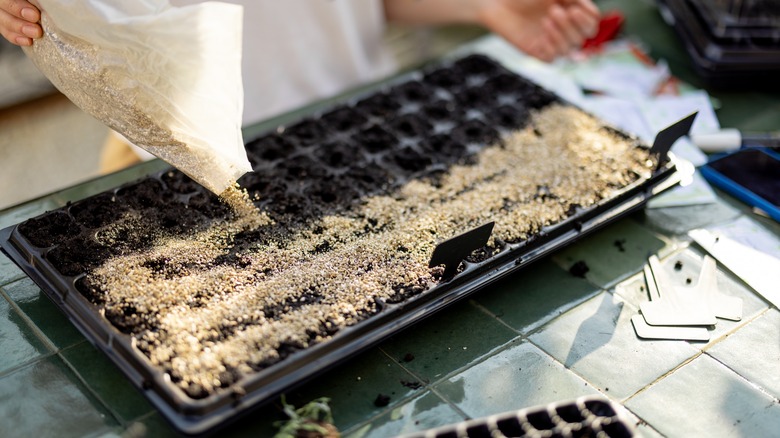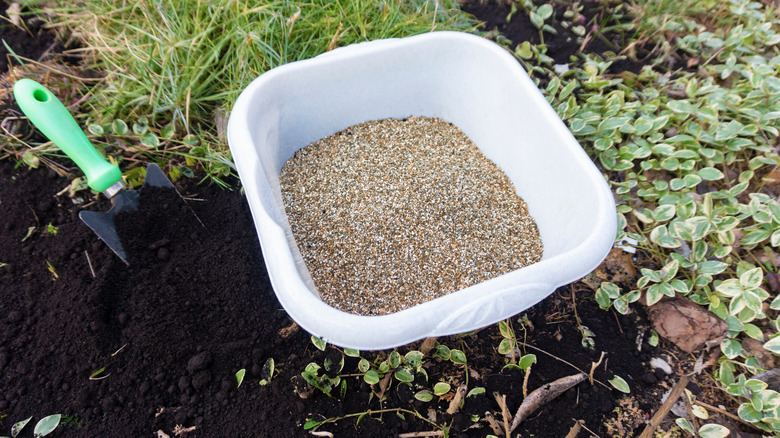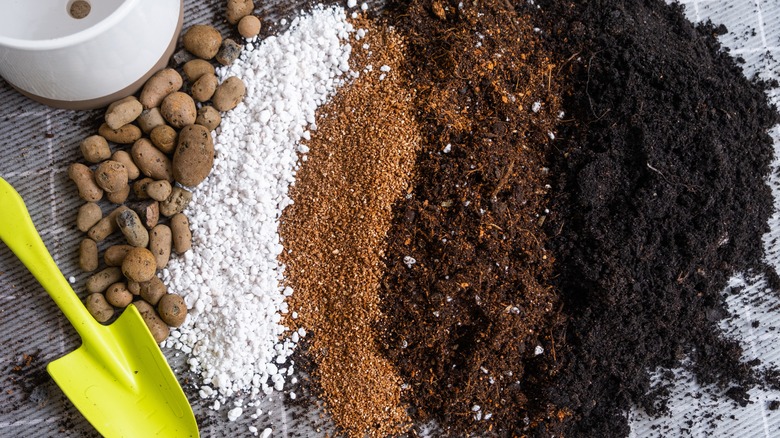How To Use Vermiculite For Efficient Seed Germination
Gardeners and horticulturists have been using vermiculite in plant propagation for many years. It's particularly useful when you want to germinate seeds quickly and effectively thanks to its unique properties. Vermiculite can be used on its own or mixed with coco coir or compost for a richer mix. If used on its own, you will need to feed your seedlings with a weak solution of liquid fertilizer once the first true leaves appear. It's also commonly found in seed-starting mixes, which are easy to use and will provide excellent results but are not essential.
What makes vermiculite so good for seed germination is that it's a completely sterile product that will not deteriorate. It's also extremely lightweight and provides excellent aeration, which is important for the young roots. Vermiculite has the added ability to retain moisture as well as nutrients once they're applied. Plus, vermiculite doesn't form a crust, which means that seed shoots can easily break through the mix when seeds are covered. That's why you can cover seeds with vermiculite only, even when you're using a standard seed-starting or potting mix or sowing your seeds straight into the garden.
The best ways to use vermiculite for seed germination
When choosing vermiculite for your seed germination, make sure that you only select horticultural grade product that originates from U.S. mines as this will give you the best results thanks to its natural properties. The best way to start seeds indoors is by using pots or seedling trays and filling these with just vermiculite. Then, just sow your seeds and cover them lightly with some more vermiculite before watering them. If you're sowing your seeds in the garden, just sow them in shallow holes and cover them with vermiculite.
Another option is to use vermiculite by mixing it with other ingredients to make a good seed-starting mix. This is especially pertinent if you're growing seeds that are slower to germinate. For example, you could mix vermiculite with coco coir in equal parts. This still creates a nice lightweight mix, but the coco coir will aid in better water retention so that your seeds don't dry out. Another possible solution is to mix equal parts of vermiculite, coco coir, and perlite. The addition of perlite will increase the drainage capabilities of the mix, which can be important for different seeds, especially those belonging to succulents. Finally, you could mix 2 parts of vermiculite with 1 part of screened compost to make your own mix. This means you won't have to feed your seedlings immediately because the compost will provide the nutrients they need until they're ready to be planted out in the garden.
Where does vermiculite come from?
Vermiculite is a clay mineral ore that is extracted from mines in different parts of the world such as the U.S., South Africa, Russia, China, and Brazil. The main vermiculite mines in the U.S. are in Montana and South Carolina. Once the vermiculite is mined, it is then heated to an extremely high temperature. This heat expands the particles, making them light and fluffy. The result is a growing medium that has good water holding capacity and offers excellent drainage. Vermiculite can also supply germinating plants with potassium and magnesium. The vermiculite that's mined in the U.S. has a pH range from 6.5 to 7.2 which is considered fairly neutral. However, the vermiculite mined in Africa can have a pH of around 9.6 or higher, which is considered alkaline. This form is also softer and lighter in color and is not recommended for use in seed germination due to its high alkalinity.
Using vermiculite on its own is perfect for seeds that germinate fairly quickly. The finest grade of vermiculite is recommended for seed germination. This medium provides excellent aeration and can hold enough moisture for the seeds to germinate readily. Now that you know how easy it is to use vermiculite to germinate your seeds, you might want to know which fruits and vegetables are easy to grow from seed in your own backyard.


